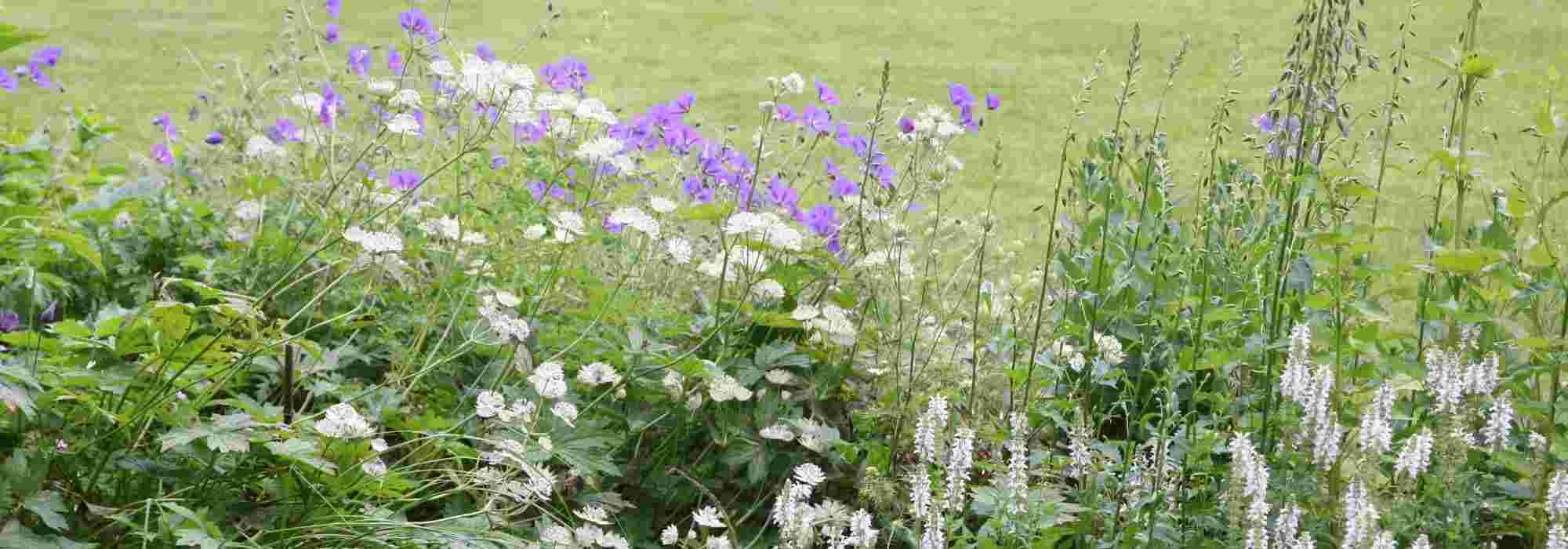
7 low‑maintenance border plants, hardy and charming
Perennial plants for a low-maintenance border
Contents
A flowerbed benefits from being edged and highlighted with border plants. While bushes such as boxwood (and its alternatives) are often showcased, it is also possible to use low perennial plants for borders that are particularly suited to this role. Selected for their small size, their spreading habit that smothers weeds and makes maintenance easier, the plants for borders highlight and complement your plantings while giving your garden a neat appearance. Charming border flowers or evergreen foliage: a wide choice, whether in dry or moister soil, in shade or sun. Here is a selection of 7 easy perennials — maintenance-free plants for borders!
Stachys
Stachys are sturdy perennials, evergreen to semi-evergreen, ideal for edging flowerbeds. Fast-growing, they spread to form dense tapeta, 20 to 40 cm high, which smother weeds very effectively. Flowers appear in summer as spikes of pink or white flowers. All Stachys are very hardy (-15 °C), robust and disease-resistant. Best known is Stachys byzantina, also called ‘Bear’s ear’ because of its grey-blue leaves, covered with a soft down to the touch. It bears small pink flowers on stems that are downy too. Cultivar ‘Big Ears’ has broader foliage, while ‘Silver Carpet’ does not flower. Stachys ‘Superba’, with glossy dark green foliage, is a deciduous species grown for its handsome purplish-pink flowering spikes. Also green, the leaves of Stachys ‘Hummelo’ form a clump topped by a very decorative summer display of purple flowers. For white flowers, choose Stachys ‘Alba’, whose large deciduous, rough leaves show a grey-tinged green. These border plants with evergreen foliage provide a lovely effect throughout the year.
Depending on species, Stachys should be planted in poor, stony soil or in richer, heavier soil. However, they do not like soils that remain waterlogged in winter. Some tolerate drought, sea spray and rain very well. They prefer sunny to semi-shaded positions.
- Discover all our Stachys varieties and read the factsheet on Stachys: planting, cultivation and maintenance.
Read also
Planting a boxwood borderJapanese herb
Hakonechloa, or Japanese herb, is a charming shade or partial-shade perennial. This grass is grown for its fine, linear foliage with an arching, supple habit. Flowering, which occurs in summer in fine panicles, remains discreet. At maturity, plant forms an elongated dome 30 to 50 cm high with a distinctly Asian look. Foliage is green in the species, variegated with pale yellow in the species-type, variegated with pale yellow in ‘Aureola’ or entirely golden in ‘All Gold’. These grasses often take on very beautiful autumn colours, such as ‘Nicolas’, ‘Naomi’ or ‘Sunflare’. Although deciduous, this grass remains decorative for much of winter as its foliage turns straw-coloured. Hakonechloa prefers neutral to acidic, loamy, deep and humus-bearing soils, though it can grow in heavier soil provided it retains good summer freshness and has adequate drainage in the dormant season. Easy to grow and hardy to at least -15 °C, it has no pests and even slugs avoid it. Slow-growing, it is one of the low perennial plants for borders ideal in woodland or dappled shade, where it softens edges with elegance.
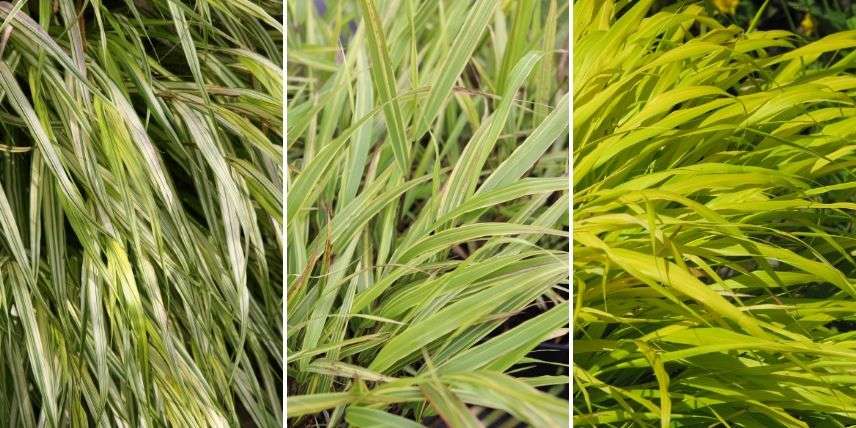
Hakonechloa macra ‘Aureola’, ‘Albostriata’ and ‘All Gold’
- Find all our varieties of Hakonechloa, as well as the fact sheet on Hakonechloa: planting, cultivation and care.
Catmints
Also known as catmints, cat mints or catnip, Nepetas are perennials highly prized for creating soft, airy flowering borders. Their light, abundant flowering makes them perfect border flowers, capable of bringing rhythm and colour throughout the growing season. Their deciduous foliage is a more or less greyish green, and ‘Six Hills Giant Gold’ offers a yellow-margined form. Very aromatic, the foliage gives off a camphor or lemon scent in the case of ‘Citriodora’. These generous perennials, of rapid growth and low-maintenance, reach 30 cm to over 1 m. They find their place at the edge of all sunny beds, from the smallest to the largest. Their large clumps, with a more or less lax habit, are lit up by a very long flowering period, from spring to summer and beyond. The small flowers, in blue or lavender spikes, then literally cover the plant. Perhaps one of the best known is ‘Six Hills Giant’, but other interesting varieties are worth discovering, for example the compact and very floriferous ‘Purrsian Blue’, suitable for small spaces.
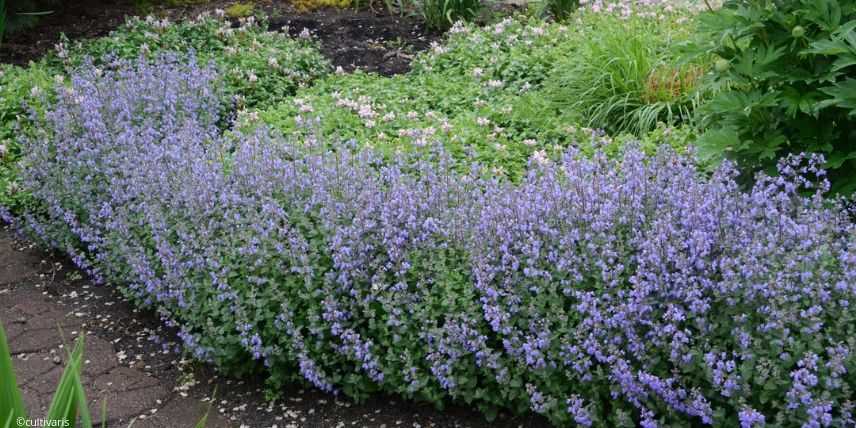
Nepeta ‘Purrsian Blue’ border
Catnips are sometimes used where growing lavenders is problematic. Hardy to −15 °C or lower, they are sun-loving perennials for poor, sandy or stony soils, even calcareous, provided drainage is good. In heavier soil, clumps can flop. Some tolerate this type of soil better, such as ‘Souvenir d’André Chaudron‘. All tolerate drought and dislike stagnant moisture.
- Discover all our varieties of Nepetas, as well as our article on planting, cultivation and maintenance of Nepetas.
Erigerons
Erigeron is one of the most popular perennials for borders, with a record flowering period that can last up to six or seven months, between spring and autumn. Very adaptable, fleabanes grow in rich or poorer soil, even rocky. They are not put off by lime or by clay soils, provided drainage is good. Sun-loving or part-shade perennials, Erigerons form bushy clumps 10–60 cm high. They withstand −10 °C to −15 °C, although their fine foliage may disappear from about −5 °C. In season, narrow leaves are studded with flowers with yellow centres, resembling daisies in white, lavender, blue or pink. For the lowest borders, the deep pink to white corollas of Erigeron karvinskianus are a must. Also try the soft lavender-blue of ‘Azur Beauty’ or the intense violet of ‘Dunkelste Aller’. Very easy to grow, these low-maintenance perennials for borders self-seed without becoming invasive and suit natural, modern or romantic gardens alike.
- Discover all our Erigeron varieties, as well as the planting and cultivation guide for Erigerons.
Hardy Geraniums
Other low-maintenance border perennials, hardy geraniums, or cranesbills, have decorative, palmate and more or less divided foliage. Deciduous to evergreen, foliage is green or purple and sometimes takes on very beautiful autumnal colours. These perennials for flowering borders are renowned for their generous, long flowering, which stretches from spring to autumn, even lasting for six consecutive months for some varieties such as ‘Rozanne’ or ‘Patricia’. Flowers, single or double, are white, blue, mauve or pink and often marked with dark or light veins. There are also varieties with bicoloured flowers. Geraniums grow either in clumps or in dense tapeta that leave little chance for weeds. There is a species for every situation. While many grow in sun or partial shade, in fairly loose, humus-bearing soil that remains cool in summer, nodosum and maccrorhizum tolerate shade, even dry shade, including between tree roots. In marshy soil, opt for Geranium maculatum, for example. Very hardy (around -20°C), rarely affected by diseases and form attractive foregrounds in borders, 20 to 60 cm high.
Honesty (Silver dollar plant)
Here is an interesting evergreen border plant! Also called Thlaspi, Iberis sempervirens edges beds year-round thanks to its foliage made up of small green leathery leaves. These perennials with woody stems adopt a flattened dome habit that is more or less regular. In spring, and even into autumn with ‘Masterpiece‘, the plant is covered with small flowers in corymbs, lightly scented and melliferous. Often white, they are violet in ‘Absolutely Amethyst‘ and pinkish-white in ‘Pink Ice‘.
These modestly sized perennials reach no more than 30 cm in height with 45 cm spreading. Sun-loving, they suit ordinary soils, light or more clayey, provided they are well drained. Stony and calcareous soils do not bother them. Disease- and drought-resistant, undemanding and hardy to about -15°C, Iberis is ideal for creating spring-flowering borders that stay tidy all year round.
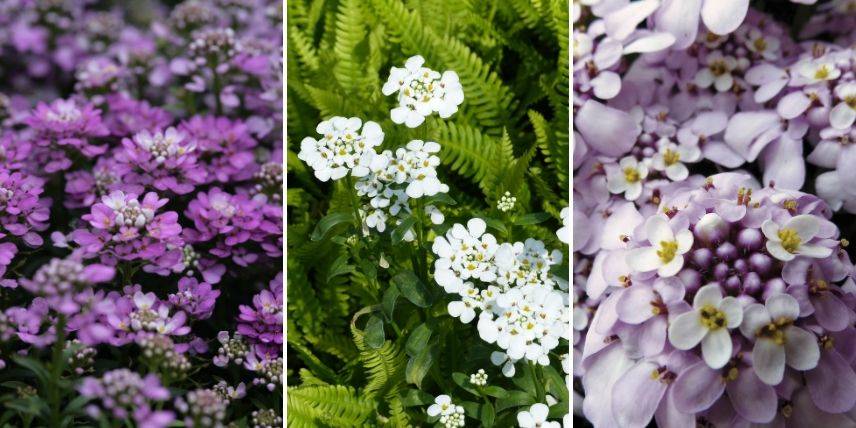
Iberis ‘Absolutely Amethyst’, ‘Masterpiece’ and ‘Pink Ice’
- Discover all our Iberis varieties, as well as the sheet on planting, sowing and maintenance of Iberis.
Bergenias
Bergenia, or shoemaker’s plant, is a rhizomatous perennial that is very accommodating. Growing 25–70 cm tall, it grows fairly slowly, in dense clumps that spread without ever becoming invasive. With a spreading habit, it bears thick, glossy evergreen foliage. Broad (up to 25 cm), foliage is green above and often purplish beneath. It is among most robust and decorative low perennial plants for borders, thanks to its generous foliage and pretty flowering. Colours change over the year, eventually turning completely crimson under cold. From late winter to spring, sturdy brown or purplish stems carry panicles of bell-shaped flowers, single to double, reminiscent of Japanese cherry blossom flowering. For a border coloured white, try ‘Bressingham White‘, or ‘Jelle‘, a recent introduction with fresh appeal. Perhaps prefer intense pink of ‘Ouvertüre‘, or pastel tone of ‘Baby Doll‘. Plant Bergenias in any well-drained soil, rich or poorer, even calcareous, provided it remains cool. They will grow in any aspect, not least because they are very hardy (down to -40 °C) and tolerate pollution and sea spray.
Find out more
Sometimes it’s necessary to support certain plants, discover how to stake perennial plants!
- Subscribe!
- Contents
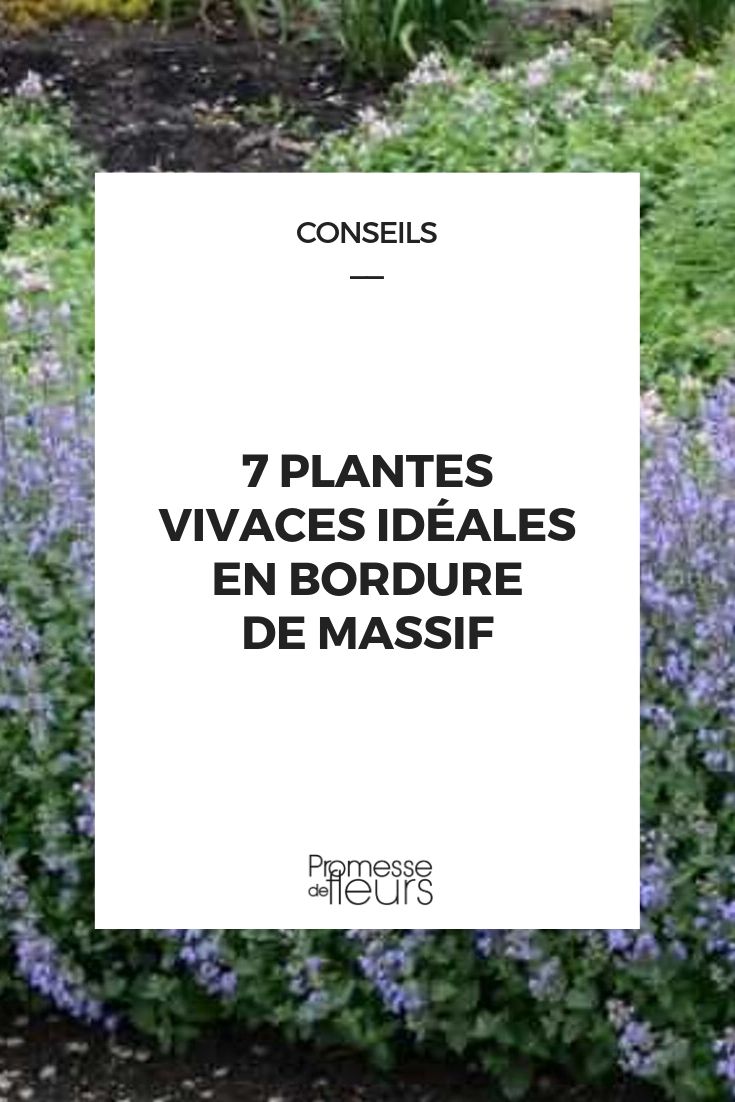































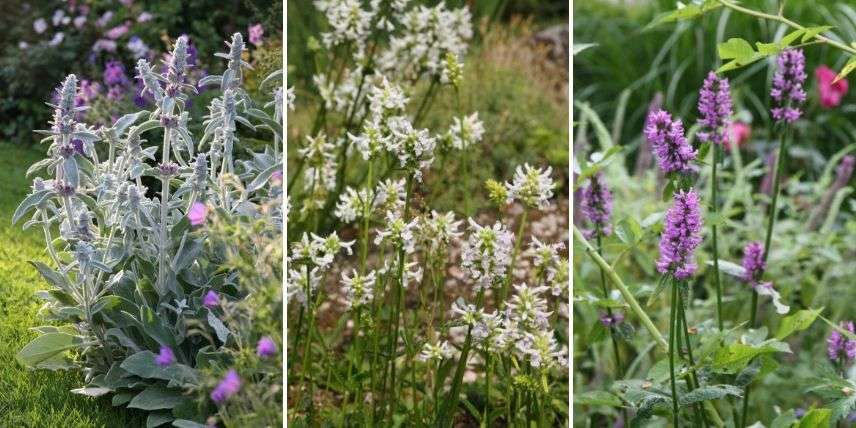
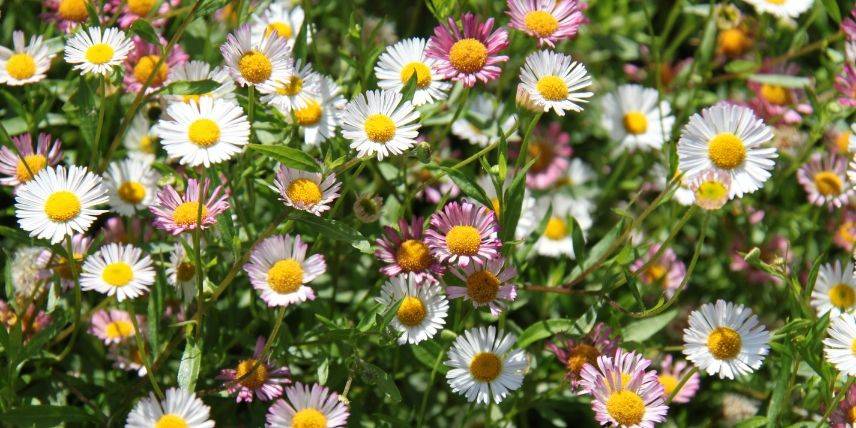
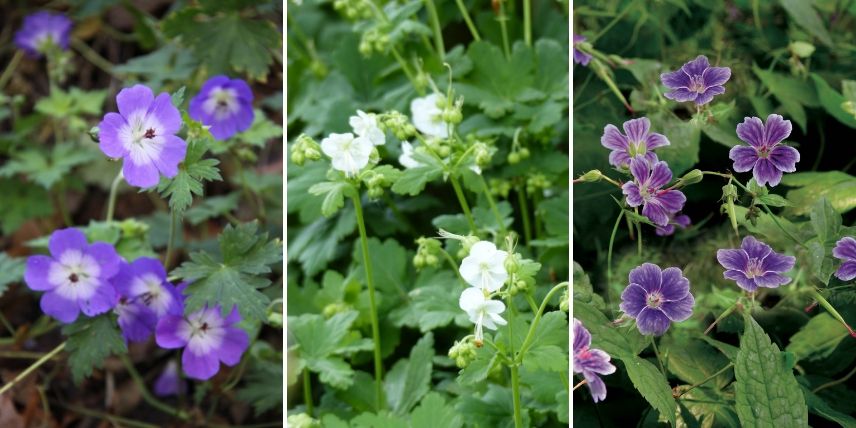
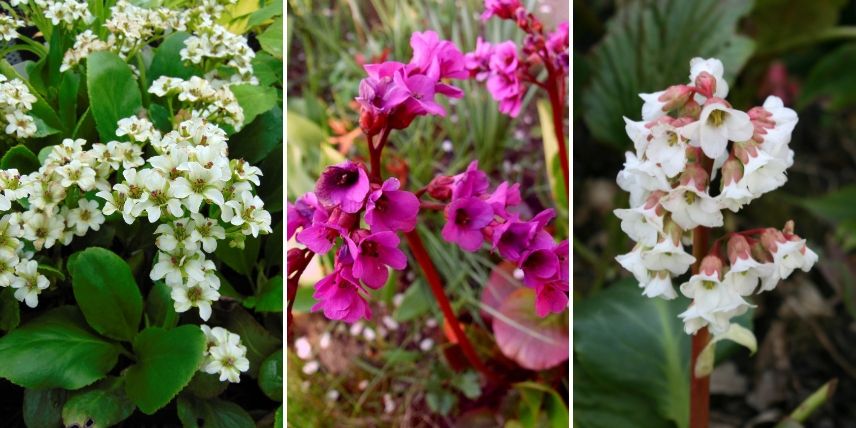
Comments